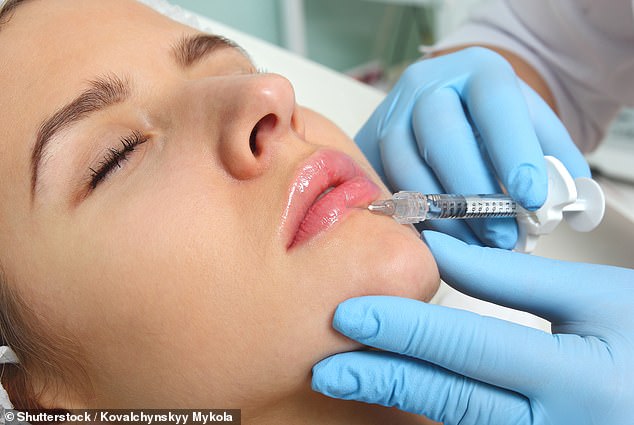Terrifying lifelong risks of lip fillers – chemicals could enter bloodstream and fuel CANCER, experts claim





Millions of women around the world see them as an easy way to get a beautiful full face.
But lip fillers could have a very unwelcome long-term effect: they can cause a rare form of cancer, experts warn.
According to them, some fillers may be contaminated with toxic manufacturing chemicals.
Additionally, when the filler breaks down, it can enter the bloodstream and build up elsewhere in the body, causing blockages.
These things could cause cell changes that lead to blood cancer, according to Dr Kalliopi Dodou, Head of Pharmacy at Teesside University.

While non-crosslinked HA is quickly broken down and absorbed by the body, the crosslinked version stays in the body much longer, which can be risky, the researchers found.
Although the research is still in its early stages, Dr Dodou says it is a potential risk that needs to be considered and calls for stricter regulation of fillers in the UK.
In a new analysis, Dr. Dodou compared 111 studies on the safety of the most common type of dermal filler – hyaluronic acid, or HA – and found reports of alarming risks.
Injections of the gel-like substance not only add volume to the lips and cheeks, but can also be used to improve the hydration and elasticity of the skin.
And the procedure is extremely popular. A 2019 poll of around 51,000 13-24 year olds by VICE UK revealed that treatments like lip fillers are becoming increasingly common.
More than half said they found these “adjustments” comparable to a haircut or manicure.
In a separate question to 60,000 people whether they had undergone cosmetic procedures such as lip fillers, only 4,000 said they had undergone such beauty treatments.
Fillers are often associated with shows like ITV’s Love Island, where many contestants have extremely ‘customised’ roles.
It caused a craze among young women who asked for extremely puffed up ‘Love Island lips’.


TV shows like Love Island have popularised lip fillers with stars including Matilda Draper (left) and Nicole Samuel (right) both opting for fuller lips.
But as cosmetic treatments become more popular, experts warn that some substances could be harmful.
DDodou explained that HA itself is not toxic, but some of the chemicals used in the production of the fillers that give the gels different thicknesses are harmful.
Although these chemicals are supposed to be “removed” from the final product, “a small amount may still remain,” she adds.
Dr. Dodou continues: ‘The more filler we use, the more we expose ourselves to residual chemicals.
‘Dermal fillers break down over time, but they can release toxins.
‘We don’t fully understand the health effects of this yet and it can be serious, especially if fillers are used too often.’
One of the studies in Dr. Dodou’s analysis, published in Cosmetics Journal, found that dermal fillers can penetrate the lymphatic system — the network of glands, also called nodes, that runs through the body and is vital to immunity.
There are more than 300 lymph nodes in the head and neck area. Some of these are located around the nose and lips. Filler is often injected here.
Dodou explained that if the filler is injected too much or incorrectly, it can block the lymph nodes that fight foreign substances, such as infections.
This can lead to swelling and increases the risk of lymph cells becoming confused, which can lead to cancers of the immune system, such as lymphoma.
However, researchers note that the hypothesis linking dermal fillers to cancer is still in its infancy.
And Marc Pacifico, chairman of the British Association of Aesthetic Plastic Surgeons, said: ‘There is no evidence that fillers cause cancer.
‘Scientific evidence shows that some fillers can affect lymphatic flow and cause lymph node obstruction.
‘With any cosmetic procedure, it is essential to go to a well-qualified and experienced physician who understands the anatomy of the face and is fully aware of the safety profile of the dermal filler being administered.’
In addition, the research raises awareness of the vision problems and blindness that can occur when fillers block the blood vessels around the eyes.
A separate five-year study found that the treatment fully restored vision in only 36 percent of cases where fillers caused such blockages.
These findings also raise serious questions about the safety of these treatments, especially when administered by individuals with inadequate training.
Although these injections are classed as medical devices, current regulations in the UK allow a wide range of practitioners to administer these injections.
The British Association of Cosmetic Nurses also warns of the lack of legislation in the UK, with Scotland being the ‘worst country in Europe for unqualified beauticians to provide cosmetic treatments to clients’, the organisation says.
An amendment to the Health and Care Act 2022 will introduce a licensing system in the UK, but no date has yet been set for its introduction.
“Our research underscores the urgent need for regulators to strengthen existing frameworks to improve consumer safety and raise standards in the cosmetics industry,” added Dr Dodou.
Although many clinics have a good reputation and perform treatments such as lip fillers successfully and without problems, more and more patients are reporting damage.

The British Association of Cosmetic Nurses has also warned about the lack of legislation in the UK, saying Scotland has been labelled the ‘worst country in Europe for unqualified beauticians to provide cosmetic treatments to clients’.
It is estimated that 900,000 Botox injections are performed each year in the UK, most of which are performed without patient complaint.
Save Face, a government-approved register of accredited practitioners, received nearly 3,000 complaints in 2022 alone, with more than two-thirds relating to dermal fillers and nearly a quarter to Botox.
Injections such as dermal fillers and Botox (the best-known brands of the substance Botulinum toxin) can cause infections and painful swelling if not administered correctly.
If a filler is accidentally injected into a blood vessel, the blood and oxygen supply to the tissue can be cut off. The tissue can then die and eventually fall off.




